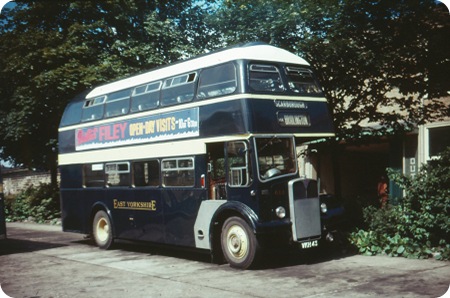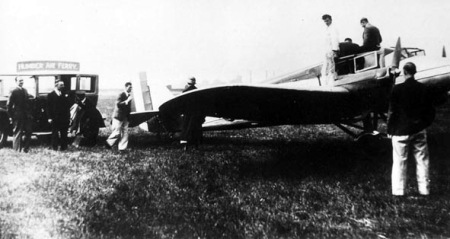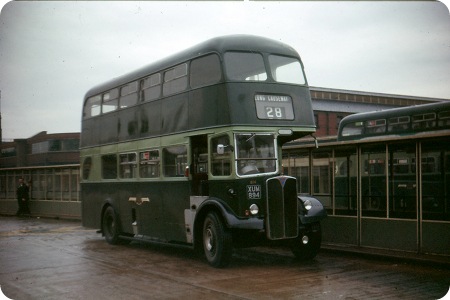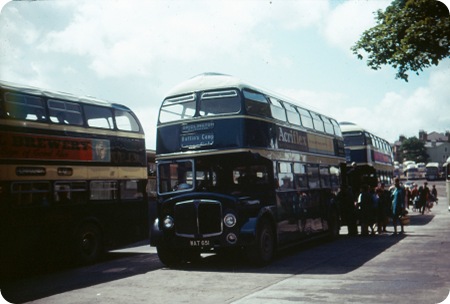
East Yorkshire Motor Services
1956
AEC Regent V
Willowbrook HBB56R
Notice the roof this shape was unique to East Yorkshire for one reason the Beverly North Bar. This is the sole survivor of the gateways into the town of Beverly the shape of the arch comes to a point requiring the roof of the bus to do the same even so it was still a tight fit.
A full list of Regent V codes can be seen here.
———
A piece of boring personal reminiscence! (But it shows, perhaps, how times have changed). Because, I think, that sitting for a long period by the window on the upper deck of a ‘Beverly Bar’ double decker could become uncomfortable, East Yorkshire permitted smoking on the lower deck. I’m unaware of any other operator who allowed it.
Roy Burke
———
It’s strange that the majority of EYMS ‘deckers had the Beverley Bar roof profile, as only a few routes actually passed beneath the bar. I believe that 229, an ex Binnington’s TD2, was the oldest vehicle to have the roof profile, when it was rebodied in 1936. The lowbridge buses were used in the Hornsea area, I think.
Keith Easton
———
11/03/11 – 16:23
Were these Regents known as ‘Blue bottles’?
Roger Broughton
———
13/03/11 – 08:09
If memory serves correctly Roger, East Yorkshire’s Leyland Titan PD2/Roe fully-fronted double-decker coaches became known as ‘Bluebottles’ after demotion to bus duties in later life. Originally painted in East Yorkshire’s attractive coach livery of primrose and blue, they were apparently known as ‘Yellow Perils’ when new. On becoming buses they received East Yorkshire’s glorious indigo and primrose livery with white roof – thus becoming ‘Bluebottles’. Whether the entire batch was downgraded, and whether the buses retained their coach seating I do not know, but they certainly looked comfortable and distinctive vehicles in either livery.
Brendan Smith
———
13/03/11 – 10:31
Brendan, I believe that the PD2 coaches did retain the luxury seating even when demoted, but I can’t honestly remember whether or not the large lower saloon luggage racks were retained – this would mean the seating capacity still being only 50. Certainly some of the batch escaped the indignity of being demoted, although I suppose if they had to be demoted at least it was to an honourable alternative with East Yorkshire, as one was preserved and appeared at rallies in primrose and light blue.
Roy, I’m sure you’re right about "smoking anywhere in the bus" as I have never encountered it elsewhere either. When I had relations in Bridlington I was a frequent traveller from Leeds, and I have to confess to contributing plenty of nicotine to the lower saloons in my misguided days – how I wish for many reasons that I’d never touched a cigarette but that’s another story.
Chris Youhill
———
14/03/11 – 07:57
Barton Transport certainly allowed smoking on both decks in the early 1970’s but I’m not sure if it was allowed until the end of their operation of double deckers.
Chris Barker
———
14/03/11 – 19:44
Brendan, I would agree with you on the naming of the PD2/12’s, and only the final eight (576 to 583) MKH 85 – 92. were downgraded to bus work. The seating was altered to FH28/26RD, thus seating 54 passengers, but I am unaware as to whether the coach seats were retained or replaced by bus seats.
Keith Easton
———
05/07/11 – 05:44
Having been absent from the EY Pages for awhile there’s a whole mass of really good info for me to read -3 pages back Chris mentions Whitby Oliver Furniture and a J5G conversion to Van, Bob Mack I think took a photo of AEC CVY 129 a converted bus. Back in 1911 and again in 1912 Olivers converted two ex London area buses. Maudslay ex Union Jack (London Road Car Co)LC4149 bonnet code R4, Platform Flat carrying a lift off rail container 1911. The second was it is thought an ex GELMO Straker made into Rully demountable top.
re-regd York so orig owner not confirmed. In the early 1920 they ran five Charas convertible to Vans, 1 Maudslay, 2 Guys 2 Karriers. One of their slogans was ‘Are your chairs Uneasy let us repair them’- try that with Bus seats, By the way EYMS operated an Air Service for a short time within the British Isles during the 1930s It departed Hedon Aerodrome.
Ian Gibbs
———
05/07/11 – 09:12
Ian, your last sentence brings back very happy memories for me (no, I’m not QUITE as old as Amy Johnson but not far off) of Hedon Aerodrome. When I was in the RAF at Patrington in 1955/6 we naturally frequently used the EYMS Hull – Withernsea service and even then the intermediate destination blinds read :-
AERODROME
HEDON
PATRINGTON
There was a filling station, still in business at that time, called "Aerodrome Garage." For a little more local flavour, how about the Hull folk’s pronunciation of the seaside resort as "Wither(UN)sea.
Chris Youhill
———
06/07/11 – 07:28
I think one of the Bluebottles was used by Halifax Corporation as a Driver Trainer. Also 647(VKH 47) was loaned to Yorkshire Woollen and then Hebble Motor Services in 1960 for fuel consumption tests.
Philip Carlton
———
06/07/11 – 09:20
The bus used by Halifax as a trainer was coach seated MKH 81 which carried the Halifax number 403 There is a photo of the bus in Halifax service on www.sct61.org.uk
Chris Hough
———
07/07/11 – 06:41
Slightly off topic here, but what’s wrong with us ‘Ull folk saying "Wither’n’sea"? What about Whitefriargate then? For the non Hull folk it’s pronounced whit’fra’gate!! Back on topic, was the Aerodrome the one at Hedon where EYMS operated the Bus-Air service in the 30’s and KHCT ran services to the Hull Speedaway in the post-war years?
Keith Easton
———
07/07/11 – 12:15
Being brought up proper and speaking proper to boot, I’m, nonetheless, a big believer in preserving local dialect – or Sheffieldish as she is spoke in the old homeland. In Sheffield, there is a select corner of the republic called Beauchief but pronounced by the locals as "Beechiff". We also share, with Doncaster, a suburb called "Inteck" – but you have to look on the buses for Intake.
David Oldfield
———
07/07/11 – 12:17
Well since you mention Hull Keith, I have to say I’m not a Hullovarian but I absolutely love the place! The first time I ever visited, I went on the ferry from New Holland and took the bus into town from Corporation Pier. I did go over the bridge soon after it opened but then many years passed before I visited again in 2009. I used to love the old bus station because it was full of atmosphere and character and the delights of the parking ground to the rear but I suppose you have to admit that the new interchange and St. Stephens has enhanced Hull considerably. I would like to ask you this; what was in the massive 5 or 6 story block between the bus station and Ferensway, was it offices? there was a street to the right of it which would have seemed a natural exit for buses but why did they go some distance further along before exiting on to Ferensway, was it by Lombard Street? I wish I’d taken more notice at the time but you never value things till they’ve gone!
Chris Barker
———
08/07/11 – 06:19
Oh ‘eck Keith, I hope I haven’t caused any offence – such was certainly not the intention – just the opposite in fact. I’ve always been a lover of local dialects and accents, and East Yorkshire and Hull in particular – I was just highlighting the delight of the extra syllable that you good ‘Ull/Spurn folk insert between the "R" and the "N" By way of apology, a pint of Moores and Robsons or Hull Brewery ale is yours when we meet !!
Chris Youhill
———
09/07/11 – 07:28
Chris Y and EY Aero buffs here is a reminder of ‘old planes’

I was given this picture to copy by an old chap I interviewed years ago with no copyright on the rear. He told me that the Air Ferry was set up to provide businessmen with a quick trip across the Humber I believe it was a charter job for each trip. The date was c1933s tickets were in triplicate coloured copies apparently being Blue Yellow White The Taxi was possibly ex-Richard Sherwoods fleet (only a theory on my part). My informant named the ‘Taxi’ as 6-cylinder Chevrolet Vehicle. So as Sherwood had 8 Chevs, one an LQ type (WF 2441) acquired by EYMS 1933 it is possibly from EYMS ownership. Anyhow EYMS provided the vehicle as transport to the Aerodrome, this photo illustrated the arrival of flight number One I was informed. I think the Aircraft may have been a Percival product.The aircraft code letters are not visible (rather like those annoying bus photos with staff in front of the Plate) so it cannot be precisely identified -or maybe from Aerodrome log books?
Briefly on the subject of R H Sherwood he owned a 1907 ‘National’ Car formerley owned by John J Ferens!
Ian Gibbs
———
10/07/11 – 07:34
Hi Chris (B), between the bus station and Ferensway, was the ABC Cinema (on the corner) with a branch of Norman Duggleby’s toy shop at the bus station corner – sheer heaven for a youngster in the ‘fifties and ‘sixties! Next to the cinema was the Electricity showrooms, next to which was a car park, but was obviously a bombed site I’m not sure what was originally there. I too spent many happy hours in the Coach Station (that sounds a bit suspect in the 21st Century, but the ‘fifties to ‘seventies were much more innocent days); indeed upon acquiring a copy of Alan Witton’s fleetbook 2 and standing in the Coach Station and Victoria square, I found that I could see 80% of the KHCT bus fleet- happy days. Ironically, being born and bred in ‘Ull, I never did get to go on the New Holland Ferry, indeed you never appreciate what you have until it has gone. As to Lombard street, the KHCT offices and central garage were on the western side of Lombard street, and several bus stand were situated adjacent to the garage/offices. I only remember the rebuilt premises as the garage took a direct hit during the horrific air raid of May, 1941.
Chris (Y) no offence taken, but if you can find a pint of Hull Brewery, then your’e on! On the topic of Hullisms, have you ever heard of Bridleberg, Withernberg and Hornberg at all? This is what we called them when young.
Peter, please accept my apologies as this is totally off topic, just the ramblings of an aging Hullensian bus enthusiast!
Keith Easton
———
11/07/11 – 07:19
Very happy indeed Keith that no offence was taken – as I explained of course only the opposite was intended. No, I’ve never encountered the "bergs" before but I did often hear (and still do from an ex Hull/LCT chap in Leeds) Patrington pronounces as "Patringumm." In the aerodrome region I have very fond memories of the prefabs on Hedon Road with enormous numbers reaching 12** etc, The Gaol (from outside I stress) Imperial Typewriters , Humbrol paints. The EYMS Withernsea service, before joining Hedon Road and passing the Aerodrome, was via Holderness Road and Southcoates Lane – I believe this still applies.
Chris Youhill
———
18/07/11 – 07:28
I chanced upon this forum while looking for pictures of Hedon aerodrome. Mr Easton’s comments on Hull Bus Station reminded me that I too spent a lot of time there in the ’50s and ’60s waiting for buses to Cottingham Road. The stop was opposite Duggleby’s; how many times must I have gazed longingly in their windows! I remember the long rows of bus stands, and used to imagine that buses from the ones at the back went to strange and forbidding places.
Stephen W.
———
22/08/11 – 11:32
The building in Ferensway contained the Regal cinema and the former Hull Electricity Department offices, later the Yorkshire Electricty Board. The car park and small road (shaped like a D on its side) was not a bomb damaged site – the former buildings were demolished when Frenesway was built in the early thirties.
For a time the "roadway" was used as a KHCT bus terminus – there’s a photo in the Hull Daily Mail of 17 March 2001 showing a bus in the site and another leaving it and turning right into Ferensway.
Malcolm Wells
———
23/08/11 – 09:51
Hi Malcolm, this comment of yours now clarifies and confirms the location of the terminal points of many Hull Corporation bus services in the early ‘thirties, which I have only come across as "bus stands situated in Ferensway, north of the electricity showrooms". Sadly I didn’t see the photo in the HDM to which you referred.
Keith Easton
———
23/08/11 – 14:20
The aeroplane used for the Brough – Waltham (i.e. Grimsby) air ferry was G-ABFR, an example of the very rare Blackburn Segrave twin engined monoplane powered by two 120 h.p. de Havilland Gipsy III engines. It went on to Redhill Flying Club in May 1936. These details come from "British Civil Aircraft since 1919" by A.J. Jackson.
Roger Cox
———
Roger Cox re East Yorks Air Ferry thank you for taking the time to post the Aircraft info-I have not looked at the Bus Photos site for some weeks so did not find your posting it is appreciated and I have added the note to the print I have it’s marvellous how these sites makes info sharing so helpful.
Whilst on East Yorkshire Fred Sharpe of Hedon had two Albions one rather old chain drive chara that came second hand from a Harrogate Hotel it had been a ferry for hotel Golfers then to Sharpes green colour source Ernie Sharp. The other a half cab Albion came from Bullocks Pontefract (Taylor Body I believe-unconfirmed.) Fred Sharpe and Ernest? Bullock were planning a through service to the East Coast exchanging passengers along the way but it never came to fruition.
——— Top of this posting ———




